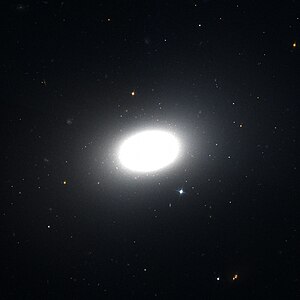NGC 1426
| Galaxy NGC 1426 |
|
|---|---|

|
|
| AladinLite | |
| Constellation | Eridanus |
|
Position equinox : J2000.0 , epoch : J2000.0 |
|
| Right ascension | 03 h 42 m 49.1 s |
| declination | -22 ° 06 ′ 30 ″ |
| Appearance | |
| Morphological type | E4 |
| Brightness (visual) | 11.3 mag |
| Brightness (B-band) | 12.3 mag |
| Angular expansion | 2.6 ′ × 1.6 ′ |
| Position angle | 111 ° |
| Surface brightness | 12.9 mag / arcmin² |
| Physical data | |
| Affiliation | Eridanus cluster SSRS group 72 LGG 97 |
| Redshift | 0.004813 ± 0.000020 |
| Radial velocity | 1443 ± 6 km / s |
|
Stroke distance v rad / H 0 |
(60 ± 4) · 10 6 ly (18.5 ± 1.3) Mpc |
| history | |
| discovery | William Herschel |
| Discovery date | December 9, 1784 |
| Catalog names | |
| NGC 1426 • PGC 13638 • ESO 549-001 • MCG -04-09-054 • 2MASX J03424911-2206301 • SGC 034038-2216.1 • GC 765 • H III 248 • h 2578 • GALEX ASC J034249.27-220631.7 • LDCE 251 NED045 | |
NGC 1426 is an elliptical galaxy of Hubble type E4 in the constellation Eridanus at the southern sky . It is estimated to be 60 million light years from the Milky Way and about 30,000 light years across .
The galaxies NGC 1414 , NGC 1415 , NGC 1422 , NGC 1439 are located in the same area of the sky .
The object was discovered by Wilhelm Herschel on December 9, 1784 .
Web links
Commons : NGC 1426 - collection of images, videos, and audio files
